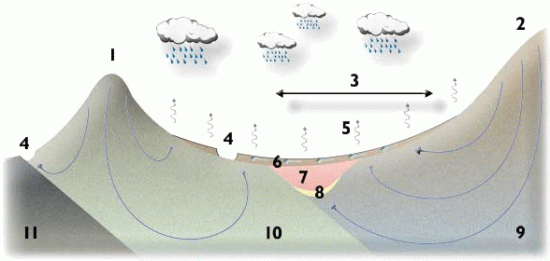TSF Geology
Geology and Hydrogeology at the Tailings Storage Facilities
The waste rock embankment site basement geology comprises predominantly rhyolite, with some dacite. Rhyolite forms the steep hills to the east of Storage 2 and all of Storage 1A. It grades from a completely weathered clay-rich surface to an unweathered rock. Dacite forms Black Hill and extends under the Ohinemuri River as far as the toe of the embankment of Storage 2. A prominent low lying ignimbrite flow is located in a paleochannel along the interface between the dacite and rhyolite.
The whole area is covered with volcanic ash except for the gullies which are filled with alluvial materials washed down from the surrounding higher ground. Peat and swampy deposits are found in many of the low lying areas.
The geology of the waste disposal area was tested by extensive drilling. Monitoring wells provided an indication of the groundwater flow pattern beneath the waste disposal area.
An important feature is the upward flowing groundwater in the waste disposal area, as evidenced by springs within the gullies. The upward rising groundwater flow is especially important because it provides natural security to prevent any seepage from the tailings storage facilities from entering the deep groundwater system. Instead, the seepage enters the under-drainage system. Subsoil drains have been constructed in strategic locations beneath the tailings storage facilities to intercept and collect groundwater seepage.

Generalised typical geological cross-section through the waste rock embankment area.
(schematic diagram only, not drawn to scale)
Above: A west to east cross-section through the waste rock embankment area.
- Motu kehu/Black Hill
- Ruahorehore Dome
- Position of Waste Disposal Area
- Ohinemuri River
- Springs
- Artesian flow through alluvial layer
- Ignimbrite
- Sediments
- Rhyolite
- Dacite
- Andesite
The geology and hydrogeology of the area are important for a number of reasons:
- the effect that they have on the stability of the land beneath the tailings storage facilities
- the groundwater system, including the direction and volume of flow
- the groundwater system and the tailings storage facility drainage systems affect each other (both surface water drainage and underdrainage systems)
- the effects of the tailings storage facilities on ground water and receiving water both during construction and in the long term.
Studies carried out prior to the original applications in 1985 determined that the then proposed site for tailings and waste rock embankments was highly favourable for the safe and secure containment of tailings and waste rock. Recent investigations have confirmed those studies.